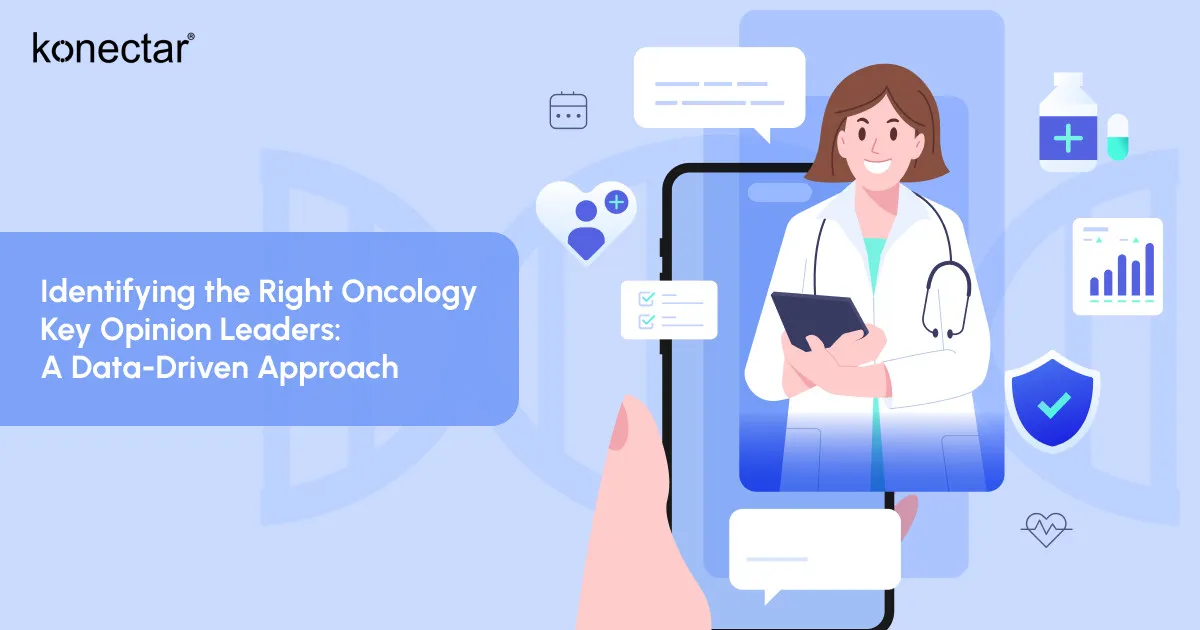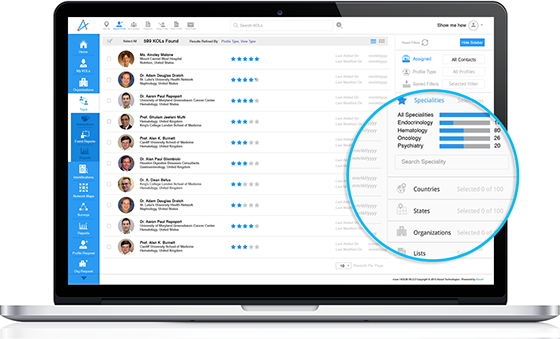15-05-2025
Identifying the Right Oncology Key Opinion Leaders: A Data-Driven Approach

When it comes to advancing oncology care, the right voices make all the difference. Whether it’s shaping treatment guidelines, designing clinical trials, or educating peers, Oncology Key Opinion Leaders (KOLs) have long served as anchors in the ever-developing cancer treatment ecosystem.
But influence today extends far beyond medical journals and conference stages.Digital Opinion Leaders in healthcare, who are actively engaging online communities are becoming just as critical to a company’s HCP engagement strategy. Understanding how to find them and what truly makes them influential is where a data-driven KOL strategy comes into play.
In this article:
- 1. Oncology Key Opinion Leaders: Understanding the New Era of Influence
- 2. Why Traditional KOL Identification Is No Longer Enough
- 3. The Role of AI and Technology in Modern Oncology Stakeholder Mapping
- 4. Best Practices for Healthcare Influencer Identification
- 5. How to Build an HCP Engagement Strategy in Oncology
- 6. The Human Element Still Matters
- 7. Final Thoughts
- 8. FAQs
Oncology Key Opinion Leaders: Understanding the New Era of Influence
Oncology moves quickly, with frequent developments that impact lives. Staying connected with clinical thought leaders has never been more important. Senior oncologists publishing landmark studies have traditionally filled this role.
Today, many of these same professionals maintain active digital presences, offering case commentary or advocating for policy changes on social media. Engaging these digital voices has become crucial for pharma and device companies – they shape discussions, spread treatment awareness, and build brand credibility in the healthcare space.
Why Traditional KOL Identification Is No Longer Enough
When it comes to KOL identification, companies often rely on manual methods such as publication counts, speaking engagements, and internal referrals. However, this approach misses key nuances.
⁕ A young oncologist might not have an extensive publication history but might run a highly followed social media channel simplifying clinical concepts for peers.
⁕ A palliative care specialist who speaks regularly on patient-centered oncology care may have more on-the-ground influence than a research-only oncologist in certain settings.
Using systems and technologies such as AI in KOL identification allows companies to analyze publication databases, social media influence, speaker records, and even sentiment data to build comprehensive profiles of healthcare opinion leaders.
The Role of AI and Technology in Modern Oncology Stakeholder Mapping
The oncology space includes thousands of physicians, researchers, and digital influencers discussing everything from immunotherapy to survivorship care.
KOL targeting software and medical influencer analytics now make it possible to distill this information meaningfully. AI-powered tools can analyze comprehensive oncology KOL data to:
⁕ Cluster stakeholders based on therapeutic focus, geography, sentiment, or platform reach
⁕ Map collaborations and co-authorships using graph-based models
⁕ Highlight rising stars who might not be visible through traditional KOL mapping
⁕ Detect patterns of influence—who’s getting shared, liked, or cited—and by whom
This layer of intelligence is what makes a data-driven KOL strategy so much more effective. It doesn’t replace human judgment—it enhances it by surfacing the right signals from noise.
Best Practices for Healthcare Influencer Identification
When you're looking to identify healthcare influencers in oncology, keep the following in mind:
⁕ Beyond the Obvious
Don’t limit your search to well-known names. Look for those involved in multidisciplinary conversations, including oncologists collaborating with genetic counselors, palliative care experts, or even patient advocates. These individuals often have a broader and more practical influence on real-world care.
⁕ Check for Consistency
A credible DOL is active, not just occasionally present. They regularly contribute to discussions, share insights, and engage meaningfully with their audience. Sporadic posting isn’t a reliable indicator of sustained influence.
⁕ Validate Their Network Influence
Influence isn’t just about reach, it’s about respect. Tools like konectar can help assess whether a DOL is engaging with other credible professionals, institutes or simply generating surface-level visibility.
⁕ Understand the Context
Influence varies across settings. Ponder questions like: Is this individual known for early adoption of new therapies? Are they trusted more in academic institutions or in community practice? Tools that support Oncology stakeholder mapping help provide this kind of situational clarity.
⁕ Leverage the Right Tools
Instead of manually tracking conversations and validating influence, consider a smarter approach. konectar, an AI-powered platform, helps you identify the right digital opinion leaders in oncology and beyond. It simplifies healthcare influencer identification, supports KOL mapping in oncology, and enables data-driven KOL strategies all in one place.
With up-to-date analytics and contextual insights, konectar ensures your HCP engagement strategy is precise, efficient, and built on real influence.
How to Build an HCP Engagement Strategy in Oncology
Once you’ve identified your opinion leaders, using a modern AI-powered platform, the real work begins. Effective engagement is never about one-size-fits-all outreach. Here’s what a thoughtful HCP engagement strategy looks like in today’s environment:
1. Intent-Based Content Strategy
Clinical thought leaders don’t just want promotional content. They appreciate scientifically sound, useful, and patient-impact-focused information. Equip them with insights they can use and share confidently.
2. Digital Amplification through DOLs
Use Digital Opinion Leaders in healthcare to spread the word organically. These DOLs act as multipliers, bridging research to practice by translating complex ideas into real-world insights.
3. Continuous Feedback Loops
DOLs and KOLs are not just messengers, they're strategic partners. Ask for their input on pipeline assets, data gaps, or patient needs. Their feedback is invaluable.
The Human Element Still Matters
Here’s the thing: no matter how advanced your KOL mapping in oncology gets, the relationships must remain personal and authentic. You can’t automate empathy, respect, or trust.
When engaging a DOL, ask:
1. What’s their motivation for writing a post on social media, is it the education, advocacy, career growth?
2. How do they prefer to collaborate - with flexibility, honoraria, or co-creation?
Digital tools are just tools. The art of engagement is still deeply human.
Final Thoughts
Oncology digital opinion leaders, when engaged thoughtfully through a data-driven KOL strategy, can accelerate innovation, spread better practices, and ultimately improve patient care. And in the digital world, where conversations shape perceptions at lightning speed, recognizing the power of DOLs isn’t optional.
To request a curated list of digital opinion leaders tailored to your objectives, or gain comprehensive social media analytics insights, get in touch with us today!
FAQs
- What are the key differences between a traditional KOL and a Digital Opinion Leader in oncology?
A traditional KOL is usually recognized for academic contributions, like publishing papers or leading trials. A DOL, while they may also be academically involved, exerts influence via digital platforms, educating peers, amplifying research, or advocating for patients online.
- How does AI improve the accuracy of KOL engagement in pharma?
AI evaluates thousands of data points including a medical professional’s clinical activity, social media, collaborations, sentiment and more, so you’re not just guessing who’s influential. You’re acting on real, current evidence.
- Is social media activity enough to define someone as a DOL in oncology?
Not entirely. Social activity should be consistent, meaningful, and clinically relevant. The best DOLs are respected clinicians or researchers who use digital tools wisely.





